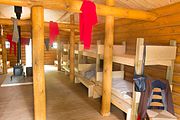
Kalamazoo is a city in and the county seat of Kalamazoo County, Michigan, United States. At the 2020 census, Kalamazoo had a population of 73,598. It is the principal city of the Kalamazoo–Portage metropolitan area in southwestern Michigan, which had a population of 261,670 in 2020.

Muskegon is a city in and the county seat of Muskegon County, Michigan, United States. Situated around a harbor of Lake Michigan, Muskegon is known for fishing, sailing regattas, and boating. It is the most populous city along Lake Michigan's Eastern shore. At the 2020 census, the city's population was 38,318. The city is administratively autonomous from adjacent Muskegon Township.

Whitehall is a city in Muskegon County in the U.S. state of Michigan. The population was 2,909 at the 2020 census. The city is located to the west of Whitehall Township. Montague is its neighbor.

WZZM is a television station licensed to Grand Rapids, Michigan, United States, serving West Michigan as an affiliate of ABC. Owned by Tegna Inc., the station has studios on 3 Mile Road NW in Walker, and its transmitter is located in Grant, Michigan.
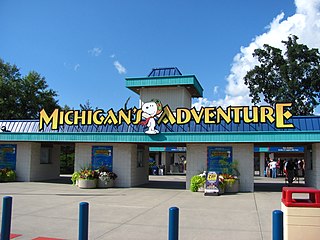
Michigan's Adventure is a 250-acre (1.0 km2) amusement park in Muskegon County, Michigan, about halfway between Muskegon and Whitehall. It is the largest amusement park in the state and has been owned and operated by Six Flags since 2024. The park was previously owned by Cedar Fair from 2001-2024. As of 2024, Michigan's Adventure has over 60 rides, slides and attractions, more than any other park in the state.
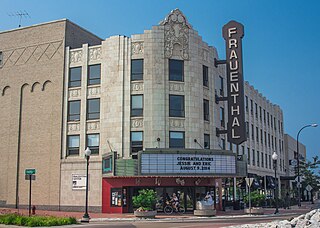
The Frauenthal Center for Performing Arts is located in downtown Muskegon in the U.S. state of Michigan. It consists of the Frauenthal Theater, formerly the Michigan Theater, and additional performance, exhibition, and support spaces in the Hilt Building. The Frauenthal Theater opened as the Michigan Theater in 1930 and was one of 17 theaters in downtown Muskegon. Today, it serves as a cultural center for Muskegon, under the management of the Community Foundation for Muskegon County.
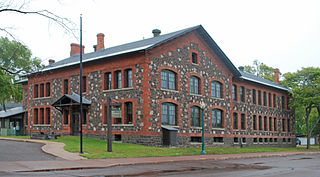
Keweenaw National Historical Park is a unit of the U.S. National Park Service. Established in 1992, the park celebrates the life and history of the Keweenaw Peninsula in the Upper Peninsula of the U.S. state of Michigan. It is a federal-local cooperative park made up of two primary units, the Calumet Unit and the Quincy Unit, and almost two dozen cooperating "Heritage Sites" located on federal, state, and privately owned land in and around the Keweenaw Peninsula. The National Park Service owns approximately 1,700 acres (690 ha) in the Calumet and Quincy Units. Units are located in Baraga, Houghton, Keweenaw, and Ontonagon counties.

Unity Christian Music Festival (Unity) is a four-day Christian music festival held annually during the month of August at Heritage Landing in Muskegon, Michigan.
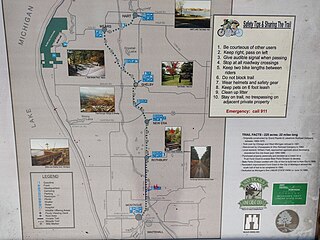
William Field Memorial Hart–Montague Trail State Park, previously and more commonly known as Hart–Montague Trail State Park, is a linear state park in Michigan that consists of a bicycle trail running from the city of Montague in Muskegon County to the city of Hart in Oceana County. The trail is very easy to ride, as it was built on former Chicago & West Michigan railroad right of way with a very low grade. The trail is also very popular for snowmobiles in the winter months.
Michigan Shipwreck Research Association (MSRA) is an American non-profit corporation based in Holland, Michigan. Formed in 2001 by the former directors of the committee which originally established the Southwest Michigan Underwater Preserve, their stated purpose is to "Preserve Michigan’s Submerged Maritime History." With the discovery of the steamer H. C. Akeley outside the boundaries of the preserve, the group broadened their area of focus and formed MSRA.

The Grand Rapids Public Museum, located on the bank of the Grand River in downtown Grand Rapids, Michigan, is among the oldest history museums in the United States. It was founded in 1854 as the "Grand Rapids Lyceum of Natural History". In 1971, the Public Museum became the first museum to be accredited by the American Association of Museums.
The Miss Michigan competition is the pageant that selects the representative for the state of Michigan in the Miss America pageant. Michigan has won the Miss America crown on five occasions.
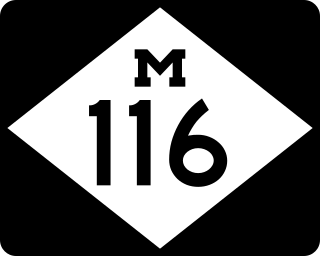
M-116 is a 7.018-mile-long (11.294 km) state trunkline highway in the US state of Michigan that begins in Ludington at an intersection with US Highway 10 (US 10) at James Street and Ludington Avenue. The road travels northward, much of it along the shore of Lake Michigan before reaching its terminus at the entrance to Ludington State Park. The roadway has been in the state highway system since the late 1920s. It has been realigned a few times, most recently in the late 1990s.

Gerber Scout Reservation (GSR), located in Twin Lake, Michigan is a resident camp owned and operated by the Michigan Crossroads Council of the Boy Scouts of America. It began operation in 1950 and had its first official summer camp program in 1951. The Original property was purchased through a gift of 275 shares from Dan Gerber, founder of the Gerber Products Company. The reservation operates two camps; Gerber Scout Camp and the Betty Ford Cub Scout and Webelos Adventureland, as well as numerous year round weekend programming outside of the summer months.
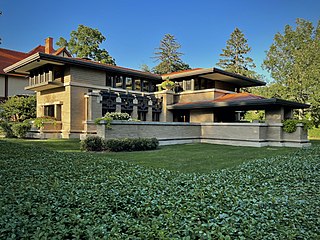
Grand Rapids is a city in and county seat of Kent County, Michigan, United States. At the 2020 census, the city had a population of 198,893, making it the second-most populous city in Michigan, after Detroit. Grand Rapids is the central city of the Grand Rapids metropolitan area, which has a population of 1,162,950 and a combined statistical area population of 1,502,552.
The Muskegon Area Transit System (MATS) is the primary provider of mass transportation in Muskegon County, Michigan. Service is provided from Monday through Friday along seven routes. The agency also provides a Complementary ADA Paratransit Service that operates within 3/4 mile of the fixed routes. A micro-transit service called Go2 provides on-demand service Monday-Saturday. Go2 is sponsored by MATS and provided by Via. In 2023, the system had a ridership of 242,300, or about 1,000 per weekday as of the second quarter of 2024.
Trinity Health Michigan, formerly Mercy Health, is a not-for-profit, integrated, managed care health care organization based in West Michigan. On April 13, 2022, Mercy Health announced it was changing its name to Trinity Health Michigan. Facilities include hospitals, treatment facilities, urgent-care facilities, as well as physician practices that serve the western Michigan area. Mercy Health is a member of the Catholic Trinity Health system.

Michillinda Lodge is a summer resort on the Lake Michigan shoreline in Whitehall, Michigan. Its current property was purchased in 1894 by a group of leaseholders and investors from Michigan, Illinois, and Indiana, and named "MICH-ILL-INDA" in reference to those states in 1895. Originally a residential beach association, in 1920 Emanuel "Manny" Duttenhofer purchased an 18-room, 13,000-square-foot (1,200 m2) summer house on the site, which he subsequently opened as a resort.

Jessica Lynn Heeringa was a 25-year-old woman from Norton Shores, Michigan, who disappeared from the Exxon gas station where she was working on the night of April 26, 2013.
Harbor Transit is the primary bus agency providing intra- and inter-city public transportation service for the Ferrysburg–Grand Haven–Spring Lake tri-cities region in northwestern Ottawa County, Michigan, which is considered part of the Grand Rapids metropolitan area. The primary year-round service is demand-responsive point-to-point transportation; in addition, Harbor Transit operates two seasonal deviated routes during the summer.













